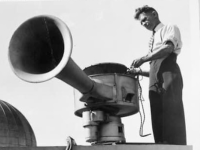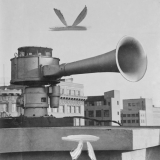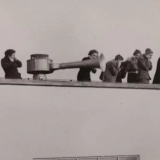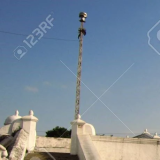Swedish Electric Co.
| Swedish Electric Company | |

| |
| Names | Swedish Electric Co. |
|---|---|
| Key people | Harold Ekman |
| Founded | 1930s |
| Defunct | 1940s? |
| Products | Air raid sirens |
Swedish Electric Company was an electrical company based out of Sweden in the 20th century. Little information about this company exists, but it is known that before and during the World War II, the company produced two models of unique civil defense sirens. Very little is known about Swedish Electric, and information is scarce on their sirens.
History
Swedish Electric Company was founded sometime in the 1930s, and presumably started producing sirens around the same time, as records show these sirens as having been made as early as the late 1930s. They were created by a Swedish engineer named Harold Ekman, who worked for the company. He created 2 siren models, a single horned rotational siren and a 3-horned omnidirectional siren. These sirens were sold across Europe and Asia, with the vast majority of examples implemented in Australia, Japan, the Netherlands, and Indonesia. In Indonesia, these sirens are now locally known as "Gauk" sirens and are used for religious purposes after the population rallied to have them brought back into service after being decommissioned in the 1970s. It is unknown exactly when production of these models ceased, as almost no information can be found about the company. However, it is likely that the company stopped making them after World War II when the need for sirens was lessened. Swedish Electric was likely defunct by the late 1940s.
Products
Note: These sirens do not have a confirmed name, and as such have been given a conjectural name.
Rotational


This was the more popular option that the company sold during World War 2, and has the distinction of being one of, if not the first rotational sirens ever built, beating the BNCO Mobil Directo by a few years. This siren is a unique small rotational siren that makes use of a rotating horn around a stationary stator, a design quirk that would later be used on the Soundmaster 125. The siren's exact specifications are unknown; however, it appears to use a 12-port rotor and stator, driven by an AC E·M·F DORDT motor located underneath the siren running at 50 Hz. The siren's decibel rating is also unknown. Unlike most rotational sirens which rotate the whole siren as one unit, this siren is an omnidirectional siren with a cap around the stator with a horn attached that rotates around the stationary stator. The cap has small teeth along the inner rim, which mesh with a small gear that is driven by a separate, smaller motor attached to the side of the chopper motor. This motor has no gear reduction drive, causing the gear to spin at full speed and causing the siren to rotate extremely fast, and is easily the fastest rotating siren ever built by design, rotating at roughly 76 rpm.

The siren's design is very simple and unique, being an omnidirectional siren with a rotating cap and horn attached. The siren uses a rotor over motor configuration, with the bare motor located underneath the rotor and stator. The siren intakes from the top, with a small cover acting as a rain shield keeping moisture and debris out of the siren. The siren has two different motors attached to each other, one driving the rotor and one directly driving the rotator gear. The siren cap surrounds the stator entirely, directing most of the siren's output through a very long, thin, rounded horn, as well as the intake. Due to the design of the horn, the siren is very directional and is nearly inaudible at a distance unless the horn is facing the listener. The fast rotation speed and directional sound causes the siren to create a "pulse" sound as it rotates. These sirens were sold in many countries, with most units ending up in Australia, Japan and the Netherlands, where they were used as air raid sirens. These would eventually be decommissioned, with Australia removing them entirely while the Netherlands opted to eventually replace them with a system of Federal Signal Modulator electronic sirens. These sirens also saw use in Indonesia as religious sirens and also sounded in the Independence Day Celebrations, and only a few examples are still currently in service in Yogyakarta, Indonesia.
Omnidirectional


This was the other option sold by Swedish Electric Co. These sirens are the same as the rotational siren, but without the separate motor to rotate the siren. The siren is a simple omnidirectional siren, using a 12-port rotor and stator driven by an AC E·M·F DORDT motor running at 50 Hz. The motor's horsepower, as well as the siren's decibel rating are both unknown. These sirens could be ordered either with or without horns. The siren's design is very simple. The siren uses a rotor over motor configuration, with the bare motor located underneath the rotor and stator. Like the rotational siren, the siren has a large cap around the stator which directs almost all of the siren's output through its horns. The siren uses three long, thin, rounded horns which are the same ones used on the rotational siren, spaced roughly 120 degrees from each other. The siren could be ordered without the cap and horns if desired. The siren intakes from the top, with a small cover acting as a rain shield to keep moisture and debris out of the siren. Like the rotational siren, the design of the siren's horns causes the siren to be very directional, with the siren being barely audible at a distance if the listener does not have a horn facing them. However, they can easily be heard for miles away if the horn is facing the listener. These sirens were not as popular as the rotational siren, with few units being sold compared to the rotational. Today, these units are only known to exist in Indonesia, being used as religious sirens. They are locally referred to as "Gauk" sirens by the local populace and are used to signal the beginning of Ramadan. Both the horned and hornless variants exist in service there, and a few examples are in service in Yogyakarta, Indonesia.